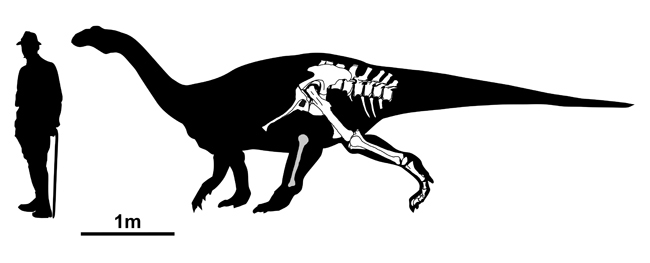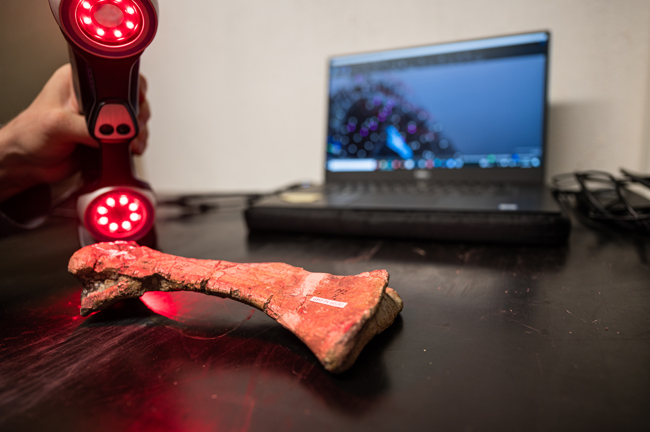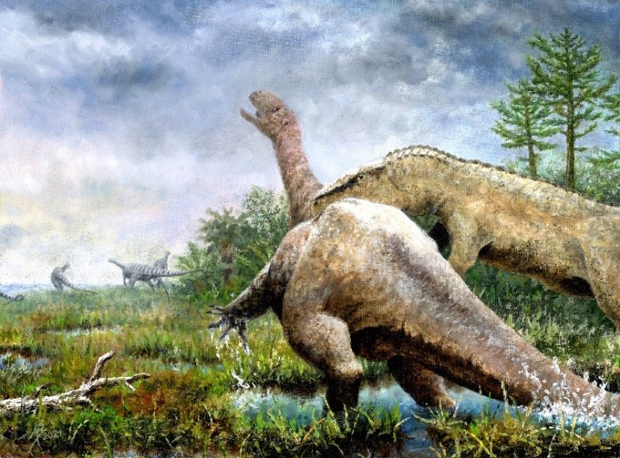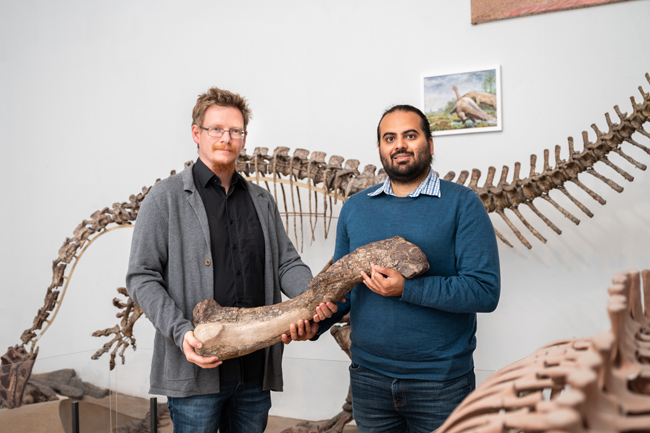Unravelling the Plateosauridae – A New Species is Announced (T. maierfritzorum)
Researchers have re-examined the fossilised remains of a Late Triassic, herbivorous dinosaur that had been assigned to the Plateosaurus genus and determined that the fossils represent a new species. The new dinosaur has been named Tuebingosaurus maierfritzorum and unlike Plateosaurus it was an obligate quadruped.

The genus Plateosaurus was erected in 1837 (Hermann von Meyer), before the term Dinosauria was coined, it was one of the first dinosaurs to be scientifically described. It has earned a reputation as somewhat of a taxonomic waste basket with numerous species assigned to it, often based on poorly preserved or fragmentary fossil remains.
Researchers at the University of Tübingen’s Senckenberg Centre for Human Evolution and Palaeoenvironment in Germany reassessed fossil bones discovered in Trossingen in 1922 and identified several unique anatomical traits leading them to conclude that these remains did not represent Plateosaurus as had previously been thought. Indeed, the bones are so different that they do not belong to a member of the Plateosauridae family, but most likely represent a member of the related clade the Massopoda.

Broader and More Robust Hips
Writing in the journal “Vertebrate Zoology”, the researchers, Dr Omar Rafael Regalado Fernandez and Dr Ingmar Werneburg demonstrate that the hips are much broader and more robust when compared with plateosaurs. In addition, the limb bones such as the femur are unusually large and the fused sacral vertebrae are characteristic of an obligate quadruped and not Plateosaurus that are believed to have been facultative bipeds (quadrupeds, but capable of walking on their hind legs if the need arose).

The Swabian Alb Mountains
The fossil bones of Tuebingosaurus maierfritzorum display characteristics of sauropods, the super-sized, long-necked dinosaurs such as Diplodocus, Brontosaurus and Brachiosaurus that dominated terrestrial faunas some fifty million years after Tuebingosaurus roamed. The fossil material is part of Tübingen’s paleontological collection. It originated from a quarry site near Trossingen at the edge of the Swabian Alb mountain range in Baden-Württemberg (Germany). The area is famous for its extensive plateosaur bonebeds and the huge amount of Plateosaurus fossils collected confirm that this lizard-hipped genus was extremely common in the Late Triassic and that Plateosaurus lived in large herds.

Following the in-depth analysis, which included scanning limb bones to provide a data source to compare to Plateosaurus fossils, the scientists concluded that these fossils represent a dinosaur more closely related to the Sauropoda than Plateosaurus.
The Trossingen Biota
Examination of the matrix material found in association with the Tuebingosaurus fossils, and the surface condition of the bones suggests that this dinosaur sunk into a swamp when it died. The bones on the left side of the body were exposed on the surface for several years and show signs of weathering.
Several different types of dinosaur are known from the Plateosaurus dominated Trossingen Formation, which dates to the Norian-Rhaetian faunal stages of the Late Triassic. Coelophysoids such as Liliensternus, which at around 5 metres long, could have predated upon Tuebingosaurus juveniles have been found. The Trossingen Formation has also yielded fragmentary fossils of other miscellaneous theropods plus evidence of different types of prosauropod.
The large rauisuchian Teratosaurus (T. suevicus) is also known from the Trossingen Formation and in the image below an unfortunate Tuebingosaurus is being attacked by this six-metre-long, predator from the crocodilian lineage of the Archosauria.

Tuebingosaurus maierfritzorum
The individual bones of Tuebingosaurus maierfritzorum (pronounced Too-bin-go-sore-us my-ah-frits-zor-um), had been stored separately but have now been united in their own permanent display case. The genus name honours the university city of Tübingen and its inhabitants, whilst the specific name pays tribute to two German zoologists, Professor Wolfgang Maier from Tübingen and Professor Uwe Fritz from Senckenberg Natural History Collections in Dresden.
This new dinosaur species has now been described in the latest edition of the Senckenberg Natural Science Society’s journal Vertebrate Zoology, which also pays tribute to Wolfgang Maier on his 80th birthday.

Everything Dinosaur acknowledges the assistance of a media release from the University of Tübingen in the compilation of this article.
The scientific paper: “A new massopodan sauropodomorph from Trossingen Formation (Germany) hidden as ‘Plateosaurus’ for 100 years in the historical Tübingen collection” by Omar Rafael Regalado Fernández, Ingmar Werneburg published in Vertebrate Zoology.
Visit the Everything Dinosaur website: Everything Dinosaur.

